CASE STUDY 9
Derwenthorpe
York

Overview
The project’s ambitions sought to establish best-practice benchmarks in place-making; sustainable transport; landscaping and ecology; and in community building in addition to the more commonplace energy and space standards, largely represented by the Code for Sustainable Homes. While some initiatives built on Rowntree’s ethos and legacy, following the precedent set by nearby model village New Earswick, others looked forward, aiming to provide a residential community that meets not only the demands of the current inhabitants but also those in the future.
The design focused on the creation of high-quality public space, with careful attention given to the design of streets, play areas, landscape and parking courtyards to ensure that all spaces were subject to overlooking and that play areas and recreational facilities were close to homes (Figure 03).


01 External view: homezone with two-bed terraced homes

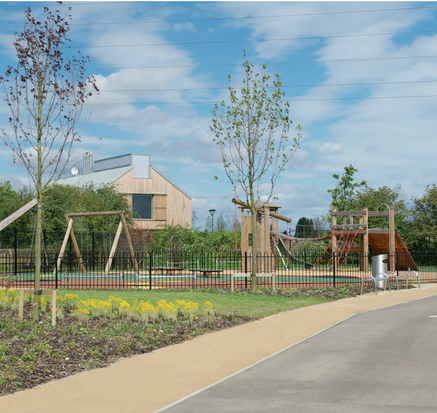
03 External view: the central play area and square, with energy centre beyond
An energy centre was built at the heart of the scheme in its initial phases, and this incorporated teaching and generous community spaces, helping to provide a focus and resource for the emerging community. As with previous JRHT pilot projects there is a recognition that leading by example also requires a certain amount of objective reflection on successes and failures, and a commitment to disseminate learning and research. Derwenthorpe has evolved into a live research project. In addition to testing fabric and technology performance, a three-year research project by York University’s Centre for Housing Policy has evaluated the in-use performance of the homes and occupant behaviour.106 Further work is being undertaken by the Building Research Establishment (BRE) on indoor air quality, and the efficacy of the mechanical ventilation with heat recovery (MVHR) systems used in the Phase 1 homes. The brief for subsequent phases (now under construction) has been modified with this learning, tempered always by the priority of making the homes affordable and accessible.
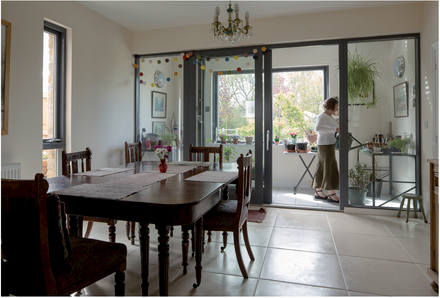
04 Internal view: living room with sunspace
Design approach
The houses are light and well proportioned with generous flexible rooms, designed to comply with the requirements both of Lifetime Homes and Standards and Quality in Development. Dual-aspect main living rooms bring natural light deep into the plan and allow cross-ventilation throughout the year, while high ceilings of 2.6m and 2.7m lend an overall sense of light and space.
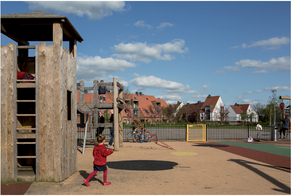
05 External view: playground
All houses have been carefully oriented, with larger windows facing south, and many houses have sunspaces to maximise useful solar gain (Figure 04). The sunspaces act as a thermal buffer throughout the year, collecting solar energy in the winter and helping to cool the houses in the summer, providing secure ventilation at a high level and making use of the stack effect for ventilation. On the street elevations the sunspaces are also used to provide a degree of privacy to the south-facing living rooms, while maintaining high levels of daylight.

06 External view: entrance porch

07 External view: entrance porch and front garden
On the garden side they provide a practical indoor/outdoor space where plants can be grown, wet clothes and boots can be left, and children can play with direct access to the garden.
All houses are designed to the same standard and with the same appearance regardless of tenure, with 40% being for rent and shared ownership and 60% for private sale. The affordable homes are ‘pepper potted’ across the whole site, avoiding grouping of tenure and promoting equality and diversity.
Environmental design
One of the key objectives at Derwenthorpe was to counter fuel poverty by reducing heating demand and by closing the performance gap. The Derwenthorpe house designs set out to safeguard the residents and reduce their vulnerability to fuel poverty by ensuring that the thermal standards were achieved on site and verified by measurement and testing. A ‘fabric first’ approach was adopted, ensuring that the basic fabric of the home and its fixed elements (walls, windows, etc.) were working as efficiently as possible. Good U-values, low air permeability, carefully controlled cold bridging and modern methods of construction were used to achieve Code for Sustainable Homes Level 4, with five homes achieving Level 5 through water-efficient fittings and appliances, and 1.75kWp of photovoltaic (PV) panels generating electricity. The design standards and construction technologies were set through the development of prototype homes, which were evaluated by the design team and a comprehensive testing regime led by the Centre for Excellence in the Built Environment, Leeds Beckett University.107
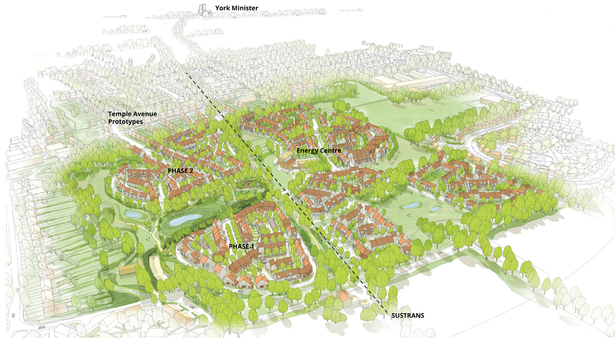
08 Aerial siteplan: Phase 1 is at bottom left
The decision to use community heating, fired by locally sourced biomass, was not only a response to government carbon targets but also an attempt to build some safeguards and self-governance into the management of residents’ energy supply, and to provide heat from locally sourced fuel.
Informed by the prototype testing, the houses were constructed using partial-fill cavity thin-bed masonry walls, and a structurally insulated panel roof system (SIPS). The masonry wall construction, with rigid PIR partial-cavity insulation and the inner thin-bed blockwork leaf, provides high insulation levels and some temperature-regulating effects via thermal mass. The SIP panel roofs are straightforward to construct and provide a robust solution for thermal performance and airtightness, due to minimal penetrations through the airtightness barrier. Trussed roof constructions with insulation at ceiling level were economical but far less robust in terms of energy performance than the SIP roofs of the majority of homes.





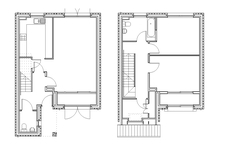
09 House types: plans and elevation – five-bed detached, extendable two-bed and three-storey town house
Monitoring and post-occupancy feedback
Testing and evaluation of the first phase at Derwenthorpe is being undertaken with four distinct approaches, each serving a particular objective:
- Mid-construction tests and inspections are regularly carried out to help maintain construction quality, particularly with regard to fabric performance and services commissioning.
- A sample of homes has been tested with a forensic post-completion test, to verify the whole-house heat loss and services installation as handed over.
- Specific technology testing is looking at recurring challenges created by the adoption of new technologies with regard to ventilation and indoor air quality.
- Wide-ranging post-occupancy monitoring covers everything from resident experiences to carbon footprinting and evidence of the emerging community, conducted over a period of three years.108
Overall there is a high level of occupant satisfaction with the design of the homes and the wider environment. The project has also been successful in reducing occupant fuel bills. However, the project has been less successful in influencing residents’ other lifestyle choices, such as transport. In addition there has been a mixed response to the biomass boiler, due to issues of operation during later construction phases and concerns over cost. This shows how difficult it can be to deliver a truly sustainable community.109
The mid and final construction testing has shown in general that construction standards are consistently high. While only a proxy for overall quality, it has been reassuring to see that all of the Phase 1 homes achieved an airtightness of around 2m3/h.m2@50 Pa with very little variation across the phase. The developer partner building the homes used airtightness testing at completion of the external walls and roof panels as well as after the services installation, helping to highlight to later trades the importance of maintaining the integrity of the various barriers and membranes and establishing the line of airtightness.
The co-heating testing can only be carried out during the winter and relies on maintaining the home for a sustained period (ideally four weeks) at a constant internal temperature of 25°C, and a temperature difference between inside and outside (‘Delta T’) of at least 15°C. The internal temperature is maintained by a resistance heater, and the heat is distributed evenly internally by fans; the energy consumption of both is monitored. Remote sensors are used to maintain the home in an effective state of steady heat loss, allowing a coefficient of heat loss or whole-house U-value to be obtained. For reliability the test is carried out over a long period to allow for the effects of external weather (for instance direct solar heating) to be accounted for in the data analysis. In terraced or attached homes the adjacent properties also have to be maintained in the heated state, so that only heat losses through the external wall and roof are represented in the overall figure. The process is long and arduous, and must be carried out by experienced researchers.

10 Heat loss: measured heat-loss coefficient compared with design prediction: all homes tested by Leeds Beckett University up to 2012

11 External view: typical three-storey house with balcony to main bedroom
A shortened version of the test was used on all the Innovate UK residential projects, but inconsistent results revealed the shortcomings of the approach. Construction teams had failed to recognise the significance of external conditions, the length required for accuracy of the results and the importance of leaving the home undisturbed during the period of the test. However, when used correctly the method is reliable. It also presents an opportunity for additional tests whose accuracy can be relied on when the steady state of heat loss is maintained, for instance thermography and heat-flux testing. Testing with heat-flux sensors at Derwenthorpe and on the prototypes established that U-values were variable in different wall constructions, highlighting both the inaccuracy of the conventional U-value calculation methods and the possible effects of weather and wind pressure within the cavity-wall constructions. Wall, floor and roof build-ups were all found to consistently under-perform when compared with the manufacturer’s predicted performance. Windows, however, showed a good correspondence between claimed values in trade literature and measurements made on site.
Post-completion testing of three of the early homes has shown a significant narrowing of the performance gap between predicted and actual energy use, with new homes coming close to the performance achieved by the prototypes. However, a notable fall-off in performance was detected in the last home to be co-heat tested,110 due possibly to a relaxation of the high quality-control standards established in the first months, but also to a decision to experiment with more conventional roof construction for the simple houses.
Testing information for the MVHR systems has revealed problems similar to the observations made by the NHBC Foundation111 in many of the Innovate UK findings, and in the One Brighton development (Case Study 8). The design criteria set for Derwenthorpe exceeded the Building Regulations Part F (Ventilation) requirements and also required improved acoustic performance. With full knowledge of the NHBC work, and the general problems the industry in the UK has found with mechanical ventilation, a lot of effort went into the design and location of the mechanical ventilation and heat recovery (MVHR) units and the coordination of ductwork. Units were made accessible for filter changing, and ductwork was on the whole well installed and correctly insulated. However, installed systems still proved noisy, and in some instances failed to deliver the required supply rates without intrusive noise. It is likely that the problems are being caused by the design of the terminals at the supply side of the system, probably exacerbated by the architect’s desire to group all roof penetrations and terminals within the purpose-made roof cowls/chimneys, and also by the extended runs of ductwork between the external fresh-air inlet and the MVHR unit. Although MVHR is increasingly used in new housing, especially urban housing (it is estimated that a quarter of all new homes have MVHR installed),112 it would seem that there is still an alarming lack of design construction and commissioning expertise in the UK.
Conclusions
Much of JRHT's research is already in the public domain and has been influential in improving the housing industry's awareness of the performance gap, and by promoting a more systematic approach to testing homes and ensuring that what is handed over to an occupier will meet the design intentions.
The work by York University has revealed interesting comparisons between the phases. Phase 1 homes were marketed as being low energy and sustainable, and many of the for-sale homes were bought by people actively wanting to pursue a sustainable lifestyle. In the second phase of generally smaller homes the emphasis has been on affordability, and residents' expectations and lifestyles can therefore be different, perhaps leading to different levels of perceived satisfaction. It will be interesting to see whether the overall ethos resonates with the ordinary as well as the 'enthusiast' residents.
A consistent finding, across all tenures, has been the appreciation of the design of the homes – appearance, spaciousness and the overall quality of the external environment – suggesting that energy targets and low-carbon ambitions may not be the only or even the most significant markers of success of the project.
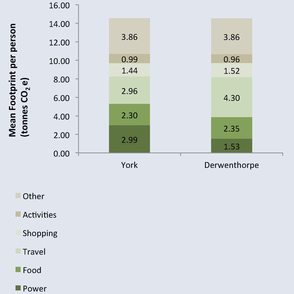
12 Ecological footprint graph


14 Percentage variation in performance graph
